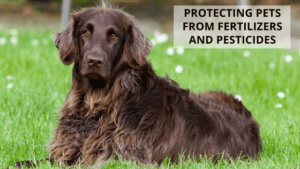
The fact of the matter is that because our pets have such a close proximity to the ground; walking with bare paws, sniffing the ground, rolling around and even eating the grass; their exposure to fertilizers and pesticides is much greater, hence, they become more vulnerable to harmful side effects. Fertilizers and pesticides have been linked to several medical concerns found in cats and dogs. Fertilizers and pesticides have been linked to aggression issues, cancers, liver damage, seizures and even death.
Because of these potential threats, in your own backyard, it’s important to take some precautionary measures in protecting your pets. Here are some helpful tips to keep your furry friends safe when using fertilizers and pesticides on your lawn:
Read the Labels
Before applying anything to your lawn or garden, be sure to read the product’s label carefully. Pay particular attention to how much should be applied and the proper means of applying the product. Also, check to see if there are any recommendations for keeping pets off a treated area.
Store the Product Properly
Fertilizers and pesticides should be always be stored properly, up and away from the reach of pets (and potentially curious kids). It is also recommended that you keep product’s in their original containers to avoid losing directions and transferring products into containers that aren’t meant to hold something like fertilizers or pesticides.
Keep a Safe Distance from Pet Gear
When using the product, be sure to keep a safe distance from your pet’s gear. Put food bowls, bones, toys and beds away before using fertilizers or pesticides that could potentially be cross-contaminated with.
Clean Up
After you’re done spreading the product, make sure you go back and clean up any product that may have been spread out onto the sidewalk or driveway.
Keep off the Lawn
Going back to reading the labels, be sure to keep pets off a treated lawn for the recommended amount of time. After waiting the recommended time, you can dilute the chemical threat by watering the area down to help reduce direct contact.
Practice Good Hygiene
Especially in the spring and fall when lawns are most likely being treated, it’s a good idea to practice good hygiene with your pets. This means giving regular baths and brushing.
Of course, if you have more questions or concerns, you should consult with your pet’s vet.


